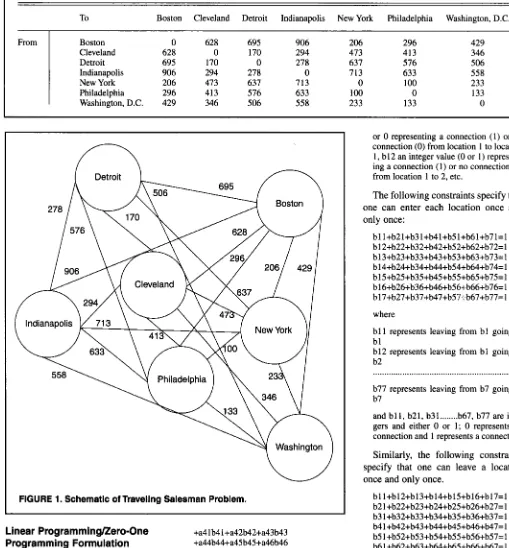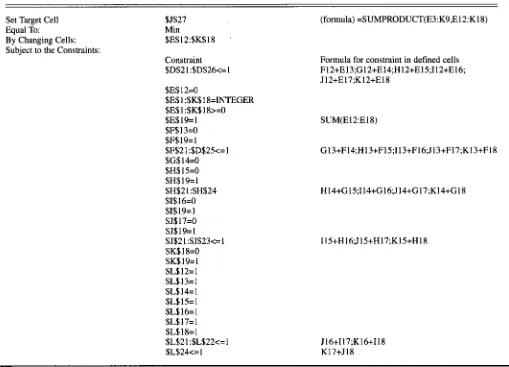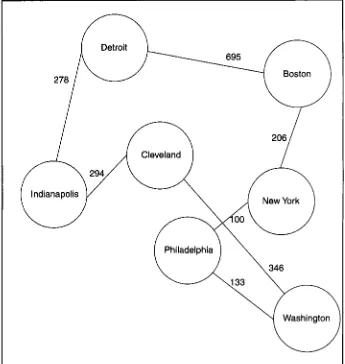Full Terms & Conditions of access and use can be found at
http://www.tandfonline.com/action/journalInformation?journalCode=vjeb20
Download by: [Universitas Maritim Raja Ali Haji] Date: 12 January 2016, At: 23:58
Journal of Education for Business
ISSN: 0883-2323 (Print) 1940-3356 (Online) Journal homepage: http://www.tandfonline.com/loi/vjeb20
An Algorithm for Using Excel Solver© for the
Traveling Salesman Problem
Mike C. Patterson & Bob Harmel
To cite this article: Mike C. Patterson & Bob Harmel (2003) An Algorithm for Using Excel Solver© for the Traveling Salesman Problem, Journal of Education for Business, 78:6, 341-346, DOI: 10.1080/08832320309598624
To link to this article: http://dx.doi.org/10.1080/08832320309598624
Published online: 31 Mar 2010.
Submit your article to this journal
Article views: 124
An Algorithm for Using
Excel Solver@ for the Traveling
Salesman Problem
MIKE C. PATTERSON
BOB HARMEL
zyxwvutsrqponmlkjihgfedcbaZYXWVUTSRQPONMLKJIHGFEDCBA
Midwestern State University
Wichita Falls, Texas
or years, the amount of time
F
required to formulate and solve linear programming problems has been a significant hurdle for researchers, business educators, and business com- munity practitioners. Linear program- ming is a powerful tool, but the lack of readily available and efficient solution algorithms has limited its practicality in many business applicationsOur purpose in this article is to dem- onstrate the efficiency of a problem- solving algorithm that uses the readily available spreadsheet add-in Microsoft Excel Solver@. We selected Solver be- cause it is widely available and has a marginal software cost of zero. It comes with the standard Microsoft Excel package. If a user has Microsoft
Office
zyxwvutsrqponmlkjihgfedcbaZYXWVUTSRQPONMLKJIHGFEDCBA
2000, he or she has Solver,which can be applied very effectively to small and medium-sized linear pro- gramming problems. For larger prob- lems, other optimization software add- ins such as Riskoptimizer and Premium Solver Platform may be pur- chased from Microsoft at a higher cost. The Traveling Salesman Problem (TSP) has challenged operations re- search enthusiasts for decades. One of the earliest articles published on the problem was “On the Hamiltonian Game (a traveling-salesman problem),” by J. B. Robinson (1949). Six years later, Dantzig, Fulkerson, and Johnson
ABSTRACT. The Traveling Sales- man Problem (TSP), well known to operations research enthusiasts, is one of the most challenging combinatorial optimization problems. In this article, the authors present one approach to solving a classic TSP through a spe- cial purpose linear programming model, zero-one programming, and Microsoft Excel@Solver.
(1954) published one of the best known TSP papers, “Solution of a Large-Scale Traveling-Salesman Problem.” That article documented the use of a special application of linear programming for solving a 49-city problem.
The objective of the TSP problem can be defined as follows:
Minimize the total distance of a tour through a given number of locations, beginning and ending the tour in the same location and entering and leaving each location once.
Over the past 50 years, mathemati- cians have studied the TSP problem extensively. One of the best known TSP projects is supported by Rice University, Rice’s Computer and Information Tech- nology Institute; the Center for Research on Parallel Computation; Digital Equip- ment Corporation; and the Keck Foun- dation. Two, of the better known TSP
Web sites are <http://www.iwr.unihei
zyxwvutsrqponmlkjihgfedcbaZYXWVUTSRQPONMLKJIHGFEDCBA
delberg.de/iwr/comopt/sofware/TSPLIB
95/> and <http://riceinfo.rice.edu/proj ects/reno/rn/l9980625/tsp.html>.
Linear programming, one of the most widely used operations research tools, is of interest to operations researchers, business college educa- tors, and business practitioners. Zero- one programming, a special form of linear programming, allows variables to take on only values of zero or one. Solver, the software add-in tool for Microsoft Excelo, also has been the model for special applications of linear programming such as the assignment (Patterson & Harmel, 2001) and trans- portation problems (Patterson & Harmel, 2002). In this article, we pre- sent an algorithm for using linear pro- gramming/zero-one programming and Solver in the solution of a seven-city traveling salesman problem.
Traveling Salesman Problem
zyxwvutsrqponmlkjihgfedcbaZYXWVUTSRQPONMLKJIHGFEDCBA
A TSP is usually presented as a table.
In Table 1, we summarize the pertinent data for our TSP. As stated previously,
the objective is to find the route that minimizes the total distance traveled and has the traveler begin in one city (e.g., Boston), enter and exit each city once, and end the trip in the beginning city (Boston). The complexity of this problem is perhaps better illustrated through a diagram (see Figure 1 for a
schematic of the problem).
zyxwvutsrqponmlkjihgfedcbaZYXWVUTSRQPONMLKJIHGFEDCBA
July/August 2003 341
TABLE 1. Road Mileage Dlstances Between Cities
zyxwvutsrqponmlkjihgfedcbaZYXWVUTSRQPONMLKJIHGFEDCBA
FromTo Boston
zyxwvutsrqponmlkjihgfedcbaZYXWVUTSRQPONMLKJIHGFEDCBA
~~ ~~
Boston Cleveland Detroit Indianapolis
New
zyxwvutsrqponmlkjihgfedcbaZYXWVUTSRQPONMLKJIHGFEDCBA
YorkPhiladelphia Washington, D.C.
0
628 695 906 206 296 429
Cleveland Detroit Indianapolis New York Philadelphia Washington, D.C. 628 695 906 206 296 429
0 170 294 473 413 346
170 0 278 637 576
zyxwvutsrqponmlkjihgfedcbaZYXWVUTSRQPONMLKJIHGFEDCBA
506294 278 0 713 633 558 473 637 713 0 100 233 413 576 633 100 0 133
346 506 558 233 133 0
zyxwvutsrqponmlkjihgfedcbaZYXWVUTSRQPONMLKJIHGFEDCBA
[image:3.612.42.551.67.615.2]u
FIGURE 1. Schematic of Traveling Salesman Problem.
Linear ProgrammingRero-One Programming Formulation
tive function for this problem:
The following represents the objec-
Minimize:
allbll+a12b12+a13b13 +a14b14+al5b 15+a 16b 16 +a17b17+a2 1 b2 1 +a22b22 +a23b23+a24b24+a25b25 +a26b26+a27b27+a31b31 +a32b32+a33b33+a34b34 +a35b35+a36b36+a37b37
+a41 b41+a42b42+a43b43 +a44b44+a45b45+a46b46 +a47b47+aSlbSl+a52b52 +a53b53+a54b54+a55b55 +a56b56+a57b57+a61b61 +a62b62+a63b63+a64b64 +a65b65+a66b66+a67b67 +a71b7 l+a72b72+a73b73 +a74b74+a75b75+a76b76 +a77b77
where a l l = value from distance table (Table 1) from row 1 column 1, a12 = dis- tance from row 1 column 2, etc.; and where b l l = an integer value of either 1
or 0 representing a connection (1) or no connection (0) from location 1 to location 1, b12 an integer value (0 or 1) represent- ing a connection (1) or no connection (0)
from location 1 to 2, etc.
The following constraints specify that one can enter each location once and only once:
bll+b21+b31+b41+b51+b61+b71=1 b12+b22+b32+b42+b52+b62+b72=1 b13+b23+b33+b43+b53+b63+b73=1 b14+b24+b34+b44+b54+b64+b74=1 blS+b25+b35+b45+b55+b65+b75=1 b16+b26+b36+b46+b56+b66+b76=1 b17+b27+b37+b47+b57:.b67+b77=1
where
bl 1 represents leaving from b 1 going to bl
b12 represents leaving from bl going to b2
b77 represents leaving from b7 going to b7
and b l l , b21, b31
...
b67, b77 are inte- gers and either 0 or 1; 0 represents no connection and 1 represents a connection.Similarly, the following constraints specify that one can leave a location once and only once.
bll+b12+b13+b14+b15+bl6+b17=1 b21+b22+b23+b24+b25+b26+b27=1 b31+b32+b33+b34+b35+b36+b37=1 b41+b42+b43+b44+b45+b46+b47=1 b51+b52+b53+b54+b55+b56+b57=1 b61+b62+b63+b64+b65+b66+b67=1 b71+b72+b73+b74+b75+b76+b77=1
The following constraints define the bmn variables as either 0 or 1 :
bll>=Obll<=l b12>=0b12<=1 b13>=0b13<=1 b76>=0b76<=1 b77>=0b77<=1
342
zyxwvutsrqponmlkjihgfedcbaZYXWVUTSRQPONMLKJIHGFEDCBA
JournalzyxwvutsrqponmlkjihgfedcbaZYXWVUTSRQPONMLKJIHGFEDCBA
of Education for BusinessThe following constraints do not allow
one to enter and leave the same city:
zyxwvutsrqponmlkjihgfedcbaZYXWVUTSRQPONMLKJIHGFEDCBA
bll=Ob22=0 b33=0b44=0 b55=0b66=0 b77=0
The final constraints are formulated for elimination of the initial subtours. Because the tour must begin and end in the same city, these subtours must be eliminated. The initial subtour con- straints are the following:
b12+b21<=lb34+b43<=1 b13+b31<=lb35+b53<=1 b14+b41<=lb36+b63<=1 b15+b51<=lb37+b73<=1 b16+b61<=lb45+b54<=1 b17+b71<=0b46+b64<=1 b23+b32<=lb47+b74<=1 b24+b42<=lb56+b65<=1 b25+b52<=lb57+b75<=1 b26+b62<=lb67+b76<=1 b27+b72<=1
These constraints prevent the model from suggesting a trip from Boston to Cleveland to Boston, from Boston to Detroit to Detroit, and so forth.
Other subtours are possible when the solver uses linear (zero-one) program- ming for traveling salesman problems. Identifying all of the possible subtours is not necessary in the initial formulation. We identify and discuss these subtours.
C
From
zyxwvutsrqponmlkjihgfedcbaZYXWVUTSRQPONMLKJIHGFEDCBA
Solver Formulation and Solution
The Solver add-in tool is located under the Tools icon in Excelo. If it is not available, it will need to be added from the custom install program fpr Excelo. Solver was developed for Microsoft by Frontline Systems Inc., which also developed similar add-ins for Lotus 123 and QuatroPro. The Web page maintained by Frontline (http:l/ www.solver.com/) provides useful in- formation regarding the use of optim- ization and the availability of more powerful versions of Solver.
To solve TSPs, one can use Microsoft Excel Solvero and follow the linear pro- gramming formulation above.
Step 1. Define two spreadsheets. These spreadsheets should be based on the typical traveling salesman problem as defined in Table 1. The first spread- sheet should contain the distance frondto each of the cities in the prob- lem. The second spreadsheet should duplicate the headings from the first matrix and should contain zeros in the body of the spreadsheet, indicating, as discussed above, no connection. We show the spreadsheets in Table 2.
Step 2. Define row and column totals for spreadsheet 2. The following is a partial listing of the definitions:
D E F
zyxwvutsrqponmlkjihgfedcbaZYXWVUTSRQPONMLKJIHGFEDCBA
G H IzyxwvutsrqponmlkjihgfedcbaZYXWVUTSRQPONMLKJIHGFEDCBA
J K To Boston Cleveland Detroit Indianapolis New York Philadelphia Washington, D.C.Boston 0 628 695 906 206 296 429
Cleveland 628 0 170 294 473 413 346
Detroit 695 170 0 278 637 576 506
Indianapolis 906 294 278 0 713 633
zyxwvutsrqponmlkjihgfedcbaZYXWVUTSRQPONMLKJIHGFEDCBA
558New York 206 473 637 713 0 100 233
Philadelphia 296 413 576 633 100 0 133
Washington, D.C. 429 346 506 558 233 133 0
To Boston Cleveland Detroit Indianapolis New York Philadelphia Washington, D.C. CellFormula
E19=SUM(E12..E18) F19=SUM(F12..FI 8)
G19=SUM(G12..G 18) L17=SUM(E17..K17) L18=SUM(E18..KI 8)
Step 3. Define the payoff cell. In this example, the payoff cell is defined in 527. The payoff is the sum of the prod- uct of spreadsheet (matrix) 1 times spreadsheet 2. The Excel@ formula to calculate the payoff is: =SUMPROD UCT(E3:K9,E 12:K 18).
Step
4.
Define the objective. This is executed by choosing “Tools/Solver,” “Set Target Cell.” The cell in this exam- ple is $J$27.Step 5 . Define the cells to change. This is done by identifying the cells in “By Changing Cells.” The cells in this example are the zero cells in spread- sheet 2: $E$12:$K$18.
Step
zyxwvutsrqponmlkjihgfedcbaZYXWVUTSRQPONMLKJIHGFEDCBA
6 . Define the constraints. This isdone in the Solver section “Subject to Constraints.” When defining the con- straints, one should refer to the linear programming section. We show the complete Solver parameters in Table 3.
Step 7. Select the appropriate options for Solver. Select “Assume Linear Model.”
From Boston 0 0 0 0 0 0 Cleveland 0 0 0 0 0 0 Detroit 0 0 0 0 0 0 Indianapolis 0 0 0 0 0 0
New York 0 0 0 0 0 0 Philadelphia 0 0 0 0 0 0
Washington, D.C. 0 0 0
zyxwvutsrqponmlkjihgfedcbaZYXWVUTSRQPONMLKJIHGFEDCBA
0 0 0July/August 2003 343
TABLE 3. Solver Formulation of Traveling Salesman Problem
zyxwvutsrqponmlkjihgfedcbaZYXWVUTSRQPONMLKJIHGFEDCBA
Set Target CellEqual To:
By Changing Cells: Subject to the Constraints:
$J$27 Min
$E$12:$K$18 Constraint $D$21:$D$26<=1 $E$12=0
$E$I:$K$l8=INTEGER $E$ 1 :$K$18>=0 $E$19=1 $F$13=0 $F$19= 1
$F$21 :$D$25<=1 $G$14=0 $H$15=0 $H$19=1 $H$21:$H$24 $1$16=0 $1$19= 1 $J$17=0
$J$19= 1
zyxwvutsrqponmlkjihgfedcbaZYXWVUTSRQPONMLKJIHGFEDCBA
$J$21 :$J$23<=1 $K$18=0 $K$l9=1 $L$12=1 $L$13=1 $L$14=1 $L$15=1 $L$16=1 $L$17=1 $L$18=1 $L$2 1 :$L$22<= 1 $L$24<= 1
(formula)
zyxwvutsrqponmlkjihgfedcbaZYXWVUTSRQPONMLKJIHGFEDCBA
=SUMPRODUCT(E3:K9,E12:K18)Formula for constraint in defined cells F12+E13;G 12+E14;H 12+E 15;112+E 16; J12+E17;K12+E18
H 14+G 15;114+G 1 6 3 14+G 17;K14+G 1 8 115+H16;JI 5+H17;K15+H 18
J 16+117;K16+118 K17+J18 TABLE 4. Initial Solution to Traveling Salesman Problem
To Boston Cleveland Detroit Indianapolis New York Philadelphia Washington, D.C. From Boston 0 0 0
Cleveland 0 0 1 Detroit 0 0 0
New York
zyxwvutsrqponmlkjihgfedcbaZYXWVUTSRQPONMLKJIHGFEDCBA
1 0 0 Indianapolis 0 I 0Philadelphia 0 0 0 Washington, D.C. 0 0 0
1 1 I
zyxwvutsrqponmlkjihgfedcbaZYXWVUTSRQPONMLKJIHGFEDCBA
0 1
0 1
0 1
0 1 0 1 1 1
0 1
1
TABLE 5. Subtour Constraints
J12+117+K16+EI 8<=3 Boston-Philadelphia-New York-Washington, D.C.-Boston
112+K16+J18+E17<=3 Boston-New York-Washington, D.C.-Philadelphia-Boston
112+J16+K17+EI 8<=3 Boston-New York-Philadelphia-Washington, D.C.-Boston
K 12+J 18+I 17+E 16<=3 Boston-Washington, D.C.-Philadelphia-New York-Boston
K12+I 18+516+E17<=3 Boston-Washington, D.C.-New York-Philadelphia-Boston . .
344
zyxwvutsrqponmlkjihgfedcbaZYXWVUTSRQPONMLKJIHGFEDCBA
Journal of Education forzyxwvutsrqponmlkjihgfedcbaZYXWVUTSRQPONMLKJIHGFEDCBA
Business [image:5.612.54.563.66.433.2]Step 8. Format the cells D12:J18 to be numbers with 0 decimal points. Extensive testing with Solver indicates that even if the values are defined as integers, Solver will frequently provide very small nonin- teger values such as 2.34444E-14. To force the spreadsheet to provide only 0 or 1 in the second spreadsheet, format these
cells
zyxwvutsrqponmlkjihgfedcbaZYXWVUTSRQPONMLKJIHGFEDCBA
as numbers with no decimals.Step 9. Select “Solve.” When the solu- tion is found, the following option is shown: “Keep Solver Solution,” which saves the final solution; “Return Original Values,” which restores the zeros to spreadsheet 2.
Step 10. Check solution for optimali-
ty. If the solution is optimal-that is, the tour begins and ends with the same city and there are no subtours-then the
process is complete.
zyxwvutsrqponmlkjihgfedcbaZYXWVUTSRQPONMLKJIHGFEDCBA
As discussed above, the problem of
[image:6.612.222.567.194.558.2]subtours is a significant factor in the TSP. In our formulation of the problem, we identified the initial obvious subtours but did not attempt to define all possible ones. Though it may be possible to iden- tify all possible subtours in smaller TSPs, in a seven-city (or larger) problem the number can become very large. The algorithm will identify suboptimal solu- tions that include subtours. A subtour occurs when the suggested optimal solu- tion does not include all of the cities and does not return to the starting city. On smaller problems, subtours might not be present. In this example, the first sug- gested solution includes a subtour (see Table 4 for the suggested path).
The solution suggested in this spread- sheet includes the route Boston-Philadel- phia-Washington, D.C.-New York-Boston. Thus, the requirement of entering and leaving each location once and only once and ending the tour in the beginning city
(Boston) is violated. This problem is ad- dressed by entering additional con- straints, as shown in the following:
J12+K17+118+E16<=3
Other combinations of these four cities should also be disallowed. One could use Solver to identify these other combinations, or one could use a deci-
Table
zyxwvutsrqponmlkjihgfedcbaZYXWVUTSRQPONMLKJIHGFEDCBA
5 will force Solver to not consid-er these subtour combinations.
By adding these constraints to the model, one finds another suggested so- lution. If other subtours are found, these must be identified and defined as con- straints. We show the suggested tour in Table 6. Because all subtours have been
eliminated from the solution, the opti- sion tree. The constraints shown in mal tour has been identified.
206
zyxwvutsrqponmlkjihgfedcbaZYXWVUTSRQPONMLKJIHGFEDCBA
1
zyxwvutsrqponmlkjihgfedcbaZYXWVUTSRQPONMLKJIHGFEDCBA
Philadelphia\
Washington
Y
zyxwvutsrqponmlkjihgfedcbaZYXWVUTSRQPONMLKJIHGFEDCBA
FIGURE 2. Optimal solution to Traveling Salesman Problem. TABLE 6. Optimal Solution to Traveling Salesman Problem
To Boston Cleveland Detroit Indianapolis New York Philadelphia Washington, D.C. From Boston 0 0 1 0
Cleveland 0 0 0 0 Detroit 0 0 0 1
Indianapolis 0 1 0 0
New York 1 0 0 0
Philadelphia 0 0 0 0 Washington, D.C. 0 0 0 0
1 1 1 1
zyxwvutsrqponmlkjihgfedcbaZYXWVUTSRQPONMLKJIHGFEDCBA
0 I
I 1
0 1
0 1 0 1
0 1
0 1
1
zyxwvutsrqponmlkjihgfedcbaZYXWVUTSRQPONMLKJIHGFEDCBA
July/August 2003 345
[image:6.612.78.565.196.739.2]The suggested tour is Boston-Detroit- Indianapolis-Cleveland-Washington, D.C.-Philadelphia-New York-Boston. The total distance for this tour is 2,052 miles.
Because this is a symmetric TSP- that is, the f r o d t o distance between cities is the same-one could reverse the order of the tour and still have an opti- mal solution, which covers 2,052 miles.
We show the suggested tour in Figure 2.
zyxwvutsrqponmlkjihgfedcbaZYXWVUTSRQPONMLKJIHGFEDCBA
Other Applications
One can use Excel Solver@ in other applications of the linear program- ming/zero-one programming approach. For example, suppose that one is aware that major construction projects are underway on the interstate highway sys- tem (in both directions) that connects Boston and New York. Even though the distance between Boston and New York might suggest that certain routes be con- sidered, the construction project might disallow these options. The model can take this into account with the following
two additional constraints:
zyxwvutsrqponmlkjihgfedcbaZYXWVUTSRQPONMLKJIHGFEDCBA
$1$12=O$E$16=0
When these constraints are added, the suggested route is Boston-Philadelphia- New York-Washington, D.C.-Cleve- land-Indianapolis-Detroit-Boston. The distance for this tour is 2,242 miles, or
190 miles longer than the first suggest- ed tour.
Excel Solvero also has a maximiza- tion option. Suppose that one is interest- ed in determining the maximum route through these seven cities. By changing
the MIN option to
zyxwvutsrqponmlkjihgfedcbaZYXWVUTSRQPONMLKJIHGFEDCBA
MAX in the originalspreadsheet from Table 2, one can find the suggested route that gives the long- est tour. That route is Boston-Indian- apolis-New York-Detroit-Philadelphia-
Cleveland-Washington D.C.-Boston, and the distance is 4,020 miles.
Limitations of Solver Model
The standard Solver add-in is limited in the size of model that it can solve. When we attempted to use this algo- rithm for problems involving more than 10 cities, we observed an error message, indicating that the problem was too large for Solver. Frontline Systems Inc. offers commercial versions of the soft- ware that are capable of solving larger problems.
Summary
In this article, we discussed a model designed for solving traveling salesman problems with Microsoft Excel Solvero. Low cost, readily available optimization software can increase the efficiency in formulating and executing linear pro-
gramming problems such as the TSP. Though other useful software add-ins are available, they are more expensive and are not readily available to many operations researchers, business profes- sors, and business practitioners. We used Solver because it is part of the standard Excelo package. There is no additional cost for having Solver; it is already in the software package. The approach that we presented uses a spe-
cial form of the linear programming model, zero-one programming. This approach and the development of spreadsheet templates based on this model should encourage the application of Excel Solver@ and other spreadsheet solutions to a wider range of operations research problems.
REFERENCES
Dantzig, G., Fulkerson, R., &Johnson, S. (1954). Solution of large-scale traveling-salesman
problem.
zyxwvutsrqponmlkjihgfedcbaZYXWVUTSRQPONMLKJIHGFEDCBA
Operations Research. 2, 393-410.Haag, S.,
zyxwvutsrqponmlkjihgfedcbaZYXWVUTSRQPONMLKJIHGFEDCBA
& Perry, J. (2002). Microsofr Excel2002 (10.22-10.23).Boston: McGraw-Hill Irwin.
Patterson, M., & Harmel, B. (2002). An algorith- mic approach for solving linear programming transportation problems using Microsoft
Solver. International Journal of Business
zyxwvutsrqponmlkjihgfedcbaZYXWVUTSRQPONMLKJIHGFEDCBA
Disci-plines, 12(1), 1-5.
Patterson, M., & Harmel, B. (2001). Using Microsoft Excel Solver for linear programming assignment problems. International Journal of
Management, l8(3), 308-3 13.
Robinson, J. B. (1949). On the Hamiltonian Game (a traveling salesman problem). RAND Research Memorandum RM-303.
346 Journal


